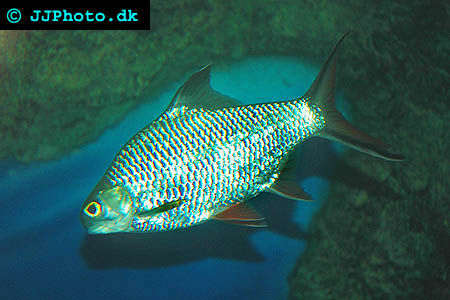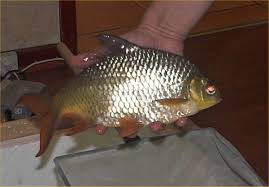Tinfoil barb description:As mentioned above, the Tinfoil barbs can easily outgrow small aquariums since they can reach a length of 35 centimetres (14 inches). Large Tinfoil barbs display a silvery or golden yellow colouration with red fins. You can distinguish the Tinfoil barb from other members of its genus by looking at the dorsal fin. The Tinfoil barb features an orange or blood-red dorsal fin decorated with a black blotch at the tip. The pectoral, pelvic and anal fins are also red and have white margins. Along each lobe, you can see a black submarginal stripe. There are 8 scale rows located between the dorsal-fin origin and the lateral line. Tinfoil barb behaviour:The Tinfoil barb is a schooling species and you should therefore always keep at least 5 specimens together. By keeping a group of Tinfoil barbs you will make the fishes much less stressed in the aquarium and you will also be able to enjoy a much broader range of natural behaviours. Shoaling Tinfoil barbs are highly active and entertaining. They spend most of their time between the bottom and the mid-level of the aquarium. Tinfoil barbs are peaceful creatures and can be housed with other docile fish species, provided of course that your aquarium is large enough. A well cared for Tinfoil barb can reach an age of 8-10 years.
Tinfoil barb setup:The recommended aquarium size for Tinfoil barbs will naturally depend on how large the specimens are, but 55 gallons (208 litres) is considered an absolute minimum. Try to mimic the natural Tinfoil barb habitat when you set up the aquarium for your Tinfoil barbs. Wild Tinfoil barbs inhabit moving waters in Asia, such as rivers, streams, canals and ditches. Tinfoil barbs will therefore appreciate currents in the aquarium. Tinfoil barb tank mates:Tinfoil barbs should always be kept together in a group consisting of at least five Tinfoil barbs. The Tinfoil bar group can be housed together with peaceful fish species of similar size or bigger. If you have a really large aquarium, you can for instance keep a group of Tinfoil barbs together with large cichlids, such as the Oscar fish (Astronotus ocellatus). Tinfoil barbs are also frequently kept together with shy and jittery fish species, since a calm Tinfoil barb group will make less tranquil fish species feel much more relaxed in the aquarium and encourage them to spend more time out in the open instead of staying hidden. Tinfoil barbs feed are chiefly herbivores, but should not be kept with crustaceans and small fishes since they can be considered food. Tinfoil barb care:The recommended temperature in a Tinfoil barb aquarium is 22 – 25°C (72 – 77°F). Wild Tinfoil barbs have however been found in a much broader temperature spectrum. Tinfoil barbs living in east Kalimantan in Indonesia have for instance been shown to adapt to a natural temperature range that stretches from 20.4 to 33.7°C (68.7 - 92.7°F). The recommended pH range for Tinfoil barbs is slightly acidic to neutral; 6.5 to 7.0. The recommended dH is 10. Tinfoil barb feeding:Wild Tinfoil barbs are chiefly herbivore creatures and will eat aquatic macrophytes, filamentous algae, submerged land plants and similar. They will however also eat insects, worms, crustaceans and small fishes. In the aquarium, Tinfoil barbs are usually happy eaters that readily accept most types of food. Healthy Tinfoil barbs will try to capture as much food as possible when you feed them. Avoiding over-feeding is important since obesity is unhealthy for all fishes. Keep your Tinfoil barbs on a varied diet can consists of an herbivore base supplemented with occasional treats in the form of worms, crustaceans and similar. Tinfoil barb breeding:The Tinfoil barb is an egg scattering species and the female Tinfoil barb can produce several thousand eggs per spawning. Sexing Tinfoil barbs is a bit tricky, since there are no obvious difference between males and females. Since Tinfoil barbs grow so large, they are not easy to breed in captivity. According to unverified sources, a public aquarium has managed to breed Tinfoil barbs in captivity at least once, but as of 2006, no public aquarium has published any details regarding how to breed Tinfoil barbs. If you want to go about breeding Tinfoil barbs, you will need an outdoor aquaculture in a tropical climate or a really big aquarium. Since the Tinfoil barbs are egg scatterers, they will not care for their eggs. Chances are high that they will eat egg and/or fry if kept together in the same aquarium. If you plan to breed Tinfoil barbs, it can therefore be a good idea to arrange a separate breeding aquarium where the offspring can be raised without the presence of adult fish. If you instead want to let the offspring stay together with the adult fish in the large aquarium, you can promote a higher fry survival by including a lot of plants in the set up. Java moss will for instance produce plenty of hiding spots for young Tinfoil barbs since Java moss produce and abundance of bushy leaves. Tinfoil barb fry will instinctively seek shelter and try to stay away from adult fish in the aquarium, just like they would do in the wild. |
||||||||||||||||||||||||||||||||||||||||||||||||||||||||||||||||||||||||||||||||||||||||||||||||||||||||||||||||||||||||||||||||||||||||||||||||||||||||||||||||||||||||||||||||||||||||||
The Tinfoil Barb is a fish that is often available in pet shops and sold to the beginning aquarist but it is not the best choice for those beginning in the freshwater hobby. The tinfoil barb requires a very large tank, at least 75 gallons (284 liters) because of its potential adult size of 13 inches (32 cm). They like to have lots of space for swimming and they are indeed fast swimmers. They also like to jump out of tanks that don't have tight fitting hoods. The sides of the Tin foil Barb resemble tin foil (hence the name) and the fins on the this barb will become more red as they mature. Juveniles (pictured below) lack the red on the fins. Tin foil Barbs will accept most fish food, including flakes, pellets, frozen and freeze-dried foods. They will also go after your live plants and any smaller fish if given the opportunity. Picture
Freshwater Fish Species Profile and Care Information Scientific Name : Barbus schwanefeldi
Common Names : River Barb Care Level : Easy to Moderate, this fish needs a larger tank Size : 13 inches (32 cm) pH : 6.0 - 7.5 Temperature : 75°F - 80°F (24°C - 27°C) Life span : 8 - 10 years Origin / Habitat : Rivers in Thailand and Sumatra Temperament / Behavior : This fish can be peaceful enough for a very large community tank, but it may eat smaller fish. Breeding / Mating / Reproduction : May be possible to breed in the home aquarium. You would need a very large tank to house the adults. Egglayer that likes higher temperatures (77 - 80°F) for breeding. Remove adults to keep them from eating the eggs. Tank Size : 75 gallon (284 liters) minimum Compatible Tank Mates : May go well with Bala Shark, Pleco, Silver Dollar and other large fish Fish Disease : Freshwater Fish Disease Diet / Fish Food : An herbivore - provide a varied diet with algae wafers, pellet food and frozen food. Tank Region : Mostly middle to top Gender : Difficult to determine Similar Species : Cyprinids, Barbs |
|
|||||||||||||||||||||||||||||||||||||||||||||||||||||||||||||||||||||||||||||||||||||||||||||||||||||||||||||||||||||||||||||||||||||||||||||||||||||||||||||||||||||||||||||||||||||||||



.jpg)